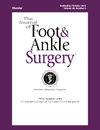法国关节镜下踝关节外侧韧带修复术后康复实践和程序。
IF 1.3
4区 医学
Q2 Medicine
引用次数: 0
摘要
目的是比较法国大容量和小容量外科医生在关节镜下踝关节外侧韧带修复(ALLR)(重建/Broström修复)后的康复实践和程序。假设是在大容量和小容量的外科医生之间在实践和程序上没有区别。2023年,一份在线问卷通过电子邮件发送给了法语关节镜学会(SFA)的成员。52名外科医生有回应,其中10名(19.2%)因未进行关节镜下全髋关节置换术而被排除。问卷主要集中在四个主题:(i)外科医生的经验和技术,(ii)固定,(iii)负重,(iv)冷冻治疗。外科医生分为高容量(≥35例/年)和低容量(本文章由计算机程序翻译,如有差异,请以英文原文为准。
Postoperative rehabilitation practices and procedures following ankle arthroscopy in France
The purpose was to compare the rehabilitation practices and procedures following arthroscopic ankle lateral ligament repair (ALLR) (reconstruction/Broström repair) among high-volume and low-volume surgeons in France. The hypothesis was that there would be no differences in practices and procedures between high-volume and low-volume surgeons. In 2023, an online questionnaire was emailed to members of the francophone arthroscopy society (SFA). Fifty-two surgeons responded, of which 10 (19.2%) were excluded as they did not perform arthroscopic ALLR. The questionnaire focused on four main topics: (i) surgeon experience and technique, (ii) immobilisation, (iii) weight-bearing, and (iv) cryotherapy. Surgeons were divided into high- (≥35 cases/year) and low-volume (<35 cases/year) surgeons, according to the number of ankle arthroscopies performed. A greater proportion of high-volume surgeons prescribe less restrictive immobilisation compared to low-volume surgeons (46% vs 22%). A smaller proportion of high-volume surgeons restrict immediate weight-bearing compared to low-volume surgeons (8% vs 33%). A greater proportion of high-volume surgeons would prescribe crutches only if patients request them, compared to low-volume surgeons (79% vs 50%). A greater proportion of high-volume surgeons prescribe cryotherapy compared to low-volume surgeons, more frequently (87% vs 78%) and immediately following surgery (46% vs 22%). This survey revealed that high-volume surgeons prescribe less restrictive immobilisation and allow earlier weight-bearing following arthroscopic ALLR, compared to low-volume surgeons. The clinical relevance is that low-volume surgeons should gain greater confidence in prescribing less restrictive immobilisation and immediate weight-bearing, based on experience of high-volume peers, which could help improve outcomes of arthroscopic ALLR and reduce healthcare and economic burdens.
求助全文
通过发布文献求助,成功后即可免费获取论文全文。
去求助
来源期刊

Journal of Foot & Ankle Surgery
ORTHOPEDICS-SURGERY
CiteScore
2.30
自引率
7.70%
发文量
234
审稿时长
29.8 weeks
期刊介绍:
The Journal of Foot & Ankle Surgery is the leading source for original, clinically-focused articles on the surgical and medical management of the foot and ankle. Each bi-monthly, peer-reviewed issue addresses relevant topics to the profession, such as: adult reconstruction of the forefoot; adult reconstruction of the hindfoot and ankle; diabetes; medicine/rheumatology; pediatrics; research; sports medicine; trauma; and tumors.
 求助内容:
求助内容: 应助结果提醒方式:
应助结果提醒方式:


